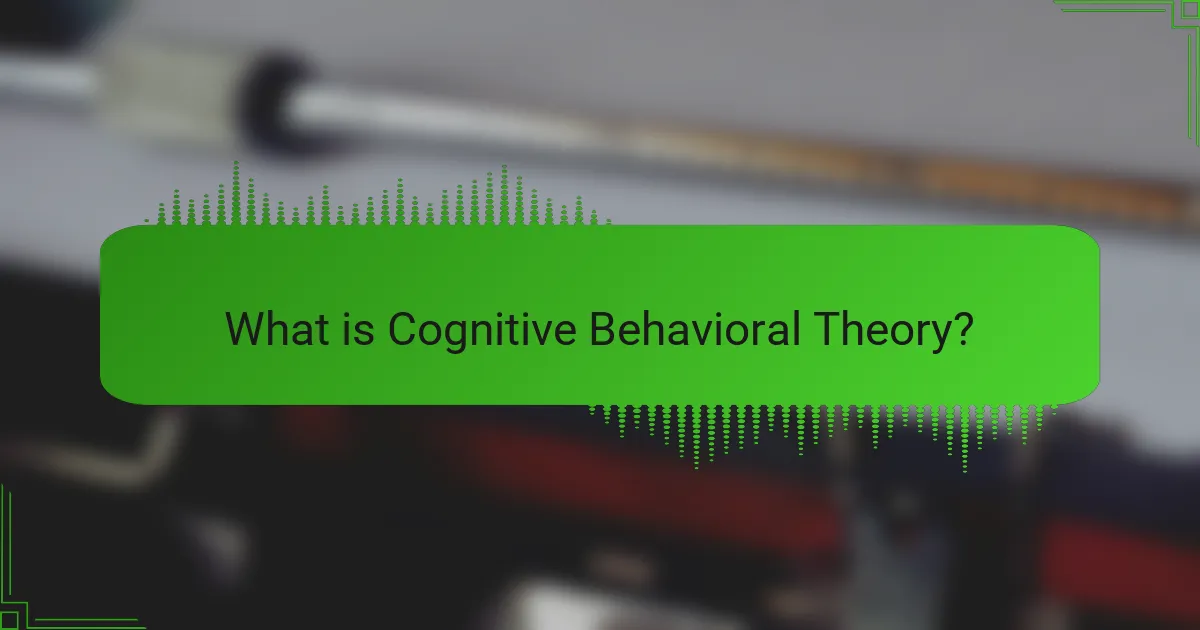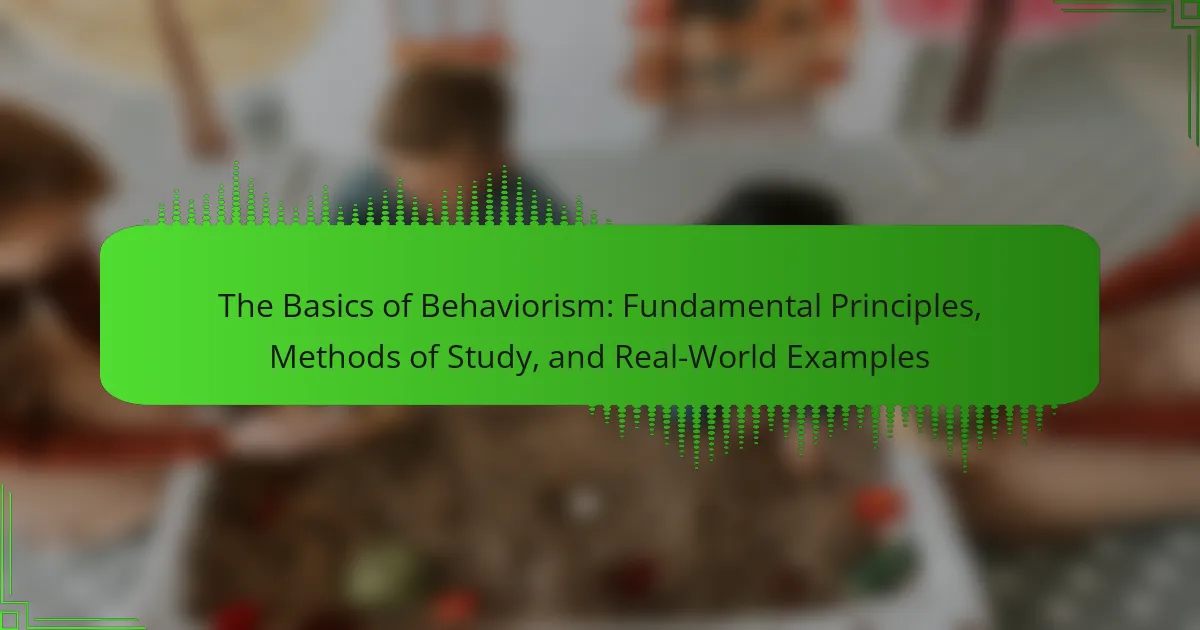Cognitive Behavioral Theory (CBT) is a psychological framework that examines the interplay between thoughts, feelings, and behaviors, emphasizing the impact of negative thought patterns on emotional well-being and behavior. This article provides an overview of CBT, highlighting its key concepts, applications in mental health treatment for disorders such as anxiety and depression, and its effectiveness demonstrated through research findings. Techniques like cognitive restructuring and behavioral activation are discussed, showcasing how CBT helps individuals develop coping strategies and improve learning outcomes in various settings, including clinical, educational, and workplace environments. The article also presents evidence of CBT’s long-term benefits, with significant symptom reduction observed in many patients.

What is Cognitive Behavioral Theory?
Cognitive Behavioral Theory (CBT) is a psychological framework that focuses on the relationship between thoughts, feelings, and behaviors. It posits that negative thought patterns can lead to emotional distress and maladaptive behaviors. CBT aims to identify and challenge these cognitive distortions. Through techniques such as cognitive restructuring and behavioral activation, individuals learn to modify their thought processes. Research has shown that CBT is effective for treating various mental health disorders, including depression and anxiety. A meta-analysis published in the Journal of Consulting and Clinical Psychology found that CBT significantly reduces symptoms in many patients. This evidence supports its application in clinical settings.
How did Cognitive Behavioral Theory develop over time?
Cognitive Behavioral Theory (CBT) developed through a combination of behavioral and cognitive approaches. In the 1950s, behaviorism dominated psychology, focusing on observable behaviors. Pioneers like B.F. Skinner emphasized reinforcement and conditioning. In the 1960s, cognitive elements began to emerge. Aaron Beck introduced cognitive therapy, highlighting the role of thoughts in emotional distress. He developed the concept of cognitive distortions, which are negative thought patterns. By the 1970s, CBT combined these approaches into a cohesive framework. This integration allowed for a more comprehensive understanding of mental health issues. Research in the 1980s and 1990s supported its effectiveness for various disorders. Today, CBT is widely used in clinical settings and is recognized as an evidence-based treatment.
What historical influences shaped Cognitive Behavioral Theory?
Cognitive Behavioral Theory (CBT) was shaped by several historical influences. It emerged from the integration of behavioral and cognitive psychology. The behavioral movement, led by figures like B.F. Skinner and John Watson, emphasized observable behavior and reinforcement. Meanwhile, cognitive psychology, influenced by researchers like Aaron Beck and Albert Ellis, focused on thought processes.
Beck developed cognitive therapy in the 1960s, addressing negative thought patterns in depression. Ellis introduced Rational Emotive Behavior Therapy, emphasizing the role of beliefs in emotional distress. These contributions laid the groundwork for CBT’s development.
The integration of these approaches resulted in a structured framework for understanding and treating psychological disorders. CBT combines cognitive restructuring with behavioral techniques to promote change. This historical blend of influences has established CBT as a widely practiced therapeutic approach.
Who are the key figures in the development of Cognitive Behavioral Theory?
Key figures in the development of Cognitive Behavioral Theory include Aaron T. Beck and Albert Ellis. Aaron T. Beck is known as the father of cognitive therapy. He developed the cognitive triad, which focuses on negative thought patterns. Albert Ellis created Rational Emotive Behavior Therapy, emphasizing the role of beliefs in emotional well-being. Their work laid the foundation for integrating cognitive and behavioral approaches in therapy. Both Beck and Ellis published influential books and research that shaped modern psychological treatment. Their theories have been validated through numerous studies, making significant contributions to psychology.
What are the fundamental principles of Cognitive Behavioral Theory?
Cognitive Behavioral Theory (CBT) is based on several fundamental principles. One principle is that thoughts influence emotions and behaviors. This means that negative thinking patterns can lead to emotional distress and maladaptive behaviors. Another principle is cognitive restructuring. This involves identifying and challenging distorted thoughts to promote healthier thinking. Behavioral activation is also a core principle. It encourages engagement in positive activities to improve mood. CBT emphasizes the importance of goal setting. Establishing clear, achievable goals helps guide the therapeutic process. Lastly, CBT is structured and time-limited. It typically involves a specific number of sessions with a focus on skills development. These principles are supported by extensive research demonstrating the effectiveness of CBT in treating various mental health conditions.
How do thoughts influence emotions and behaviors in Cognitive Behavioral Theory?
Thoughts significantly influence emotions and behaviors in Cognitive Behavioral Theory (CBT). CBT posits that cognitive processes shape emotional responses and subsequent actions. Negative thoughts can lead to feelings of anxiety or depression. For instance, believing one is incapable can result in avoidance behaviors. Conversely, positive thoughts can enhance motivation and resilience. Research shows that cognitive restructuring, a CBT technique, effectively alters maladaptive thoughts. This change can lead to improved emotional well-being and behavior modification. Studies indicate that CBT can reduce symptoms of various mental health disorders by targeting these thought-emotion-behavior connections.
What role do cognitive distortions play in Cognitive Behavioral Theory?
Cognitive distortions are central to Cognitive Behavioral Theory (CBT). They represent irrational thoughts that can negatively influence emotions and behaviors. CBT aims to identify and challenge these distortions. This process helps individuals develop more balanced thinking patterns. Common cognitive distortions include all-or-nothing thinking and overgeneralization. Research shows that addressing these distortions can lead to improved mental health outcomes. Studies indicate that CBT reduces symptoms of anxiety and depression by targeting these thought patterns. Thus, cognitive distortions play a crucial role in the effectiveness of CBT.
What techniques are commonly used in Cognitive Behavioral Theory?
Cognitive Behavioral Theory employs several techniques to modify dysfunctional thoughts and behaviors. Common techniques include cognitive restructuring, which involves identifying and challenging negative thought patterns. Another technique is exposure therapy, where individuals confront feared situations gradually. Behavioral activation is also used to encourage engagement in positive activities. Mindfulness practices help individuals stay present and reduce anxiety. Problem-solving skills training enhances coping strategies for daily challenges. Finally, self-monitoring allows individuals to track their thoughts and behaviors effectively. These techniques are supported by numerous studies demonstrating their efficacy in treating various psychological disorders.
How does Cognitive Behavioral Therapy (CBT) implement these techniques?
Cognitive Behavioral Therapy (CBT) implements techniques through structured interventions. It focuses on identifying negative thought patterns. CBT encourages clients to challenge these thoughts. This process often involves cognitive restructuring. Clients learn to replace irrational beliefs with rational ones. Behavioral activation is another key technique used in CBT. It encourages engagement in positive activities to improve mood. Research shows that CBT effectively reduces symptoms of anxiety and depression. A meta-analysis by Hofmann et al. (2012) supports its efficacy across various disorders.
What are the steps involved in a typical CBT session?
A typical Cognitive Behavioral Therapy (CBT) session involves several key steps. First, the therapist establishes a rapport with the client. This helps create a safe and trusting environment. Next, the therapist reviews the client’s progress since the last session. This may include discussing homework assignments or any challenges faced.
Then, the therapist identifies specific issues or goals for the session. The therapist and client collaboratively set an agenda for what will be covered. After that, the therapist introduces cognitive and behavioral techniques tailored to the client’s needs. This might involve challenging negative thoughts or practicing new coping skills.
Finally, the session concludes with a summary of what was discussed. The therapist may assign homework to reinforce the skills learned. Research indicates that structured sessions enhance the effectiveness of CBT (Hofmann et al., 2012, Cognitive Therapy and Research).

What are the applications of Cognitive Behavioral Theory?
Cognitive Behavioral Theory (CBT) has multiple applications in mental health treatment. It is primarily used for treating anxiety disorders, depression, and PTSD. CBT helps individuals identify and change negative thought patterns. This approach is effective in teaching coping strategies. It can also be applied in educational settings to improve learning outcomes. Additionally, CBT is utilized in workplace environments to enhance employee well-being. Research shows that CBT significantly reduces symptoms of various psychological disorders. Studies indicate that around 60-70% of patients experience improvement after CBT.
In what contexts is Cognitive Behavioral Theory applied?
Cognitive Behavioral Theory (CBT) is applied in various contexts, primarily in mental health treatment. It is commonly used to address anxiety disorders, depression, and post-traumatic stress disorder (PTSD). CBT helps individuals identify and change negative thought patterns. This approach is effective in both individual and group therapy settings. Additionally, CBT is utilized in educational settings to improve student behavior and learning outcomes. Research indicates that CBT can also be beneficial in managing chronic pain and insomnia. Its structured format allows for measurable progress, making it a preferred method in clinical practice.
How is Cognitive Behavioral Theory used in clinical settings?
Cognitive Behavioral Theory (CBT) is widely used in clinical settings to treat various mental health disorders. It focuses on identifying and changing negative thought patterns and behaviors. Therapists guide patients in recognizing their cognitive distortions. This process helps patients develop healthier thinking patterns. CBT is effective for conditions like depression, anxiety, and PTSD. Research shows that CBT can lead to significant improvements in symptoms. Studies indicate that about 60-80% of patients benefit from CBT interventions. The structured approach of CBT allows for measurable progress over time.
What role does Cognitive Behavioral Theory play in educational environments?
Cognitive Behavioral Theory (CBT) plays a significant role in educational environments by enhancing students’ learning and emotional well-being. CBT helps students identify and modify negative thought patterns that can hinder academic performance. It promotes self-regulation and coping strategies, enabling students to manage stress and anxiety effectively. Research shows that CBT techniques improve motivation and resilience among learners. A study by Hofmann et al. (2012) indicates that CBT can lead to significant improvements in academic outcomes. By integrating CBT into educational practices, teachers can foster a supportive learning environment that encourages positive behavioral changes.
What populations benefit from Cognitive Behavioral Theory?
Cognitive Behavioral Theory benefits various populations, including individuals with anxiety disorders. Research shows that CBT effectively reduces symptoms in these patients. It also aids those suffering from depression, improving mood and cognitive patterns. Additionally, CBT is beneficial for individuals with PTSD, helping them process traumatic experiences. Children and adolescents can also benefit from CBT, particularly in managing behavioral issues and emotional regulation. Furthermore, individuals with substance use disorders find CBT helpful in developing coping strategies. Studies indicate that diverse groups, including different age ranges and cultural backgrounds, respond positively to CBT interventions.
How does Cognitive Behavioral Theory support individuals with anxiety disorders?
Cognitive Behavioral Theory (CBT) supports individuals with anxiety disorders by providing structured methods to identify and challenge negative thought patterns. CBT emphasizes the connection between thoughts, feelings, and behaviors. It teaches individuals to recognize distorted thinking that contributes to anxiety. Through techniques like cognitive restructuring, individuals learn to replace negative thoughts with more balanced ones. Evidence shows that CBT can reduce anxiety symptoms effectively. A meta-analysis by Hofmann et al. (2012) found that CBT significantly improves anxiety outcomes in various populations. This approach equips individuals with practical coping strategies, fostering long-term resilience against anxiety.
What effectiveness does Cognitive Behavioral Theory have in treating depression?
Cognitive Behavioral Theory (CBT) is highly effective in treating depression. CBT focuses on identifying and changing negative thought patterns and behaviors. Research shows that CBT can significantly reduce depressive symptoms. A meta-analysis by Hofmann et al. (2012) revealed that CBT is effective for various forms of depression. Approximately 50-75% of patients with depression report symptom improvement after CBT. This therapy often leads to long-lasting changes in thought processes. Therefore, CBT is a validated approach for managing and alleviating depression.
What are the limitations of Cognitive Behavioral Theory?
Cognitive Behavioral Theory (CBT) has several limitations. It may not address deeper emotional issues. CBT primarily focuses on changing thought patterns. This can overlook underlying psychological problems. Some individuals may require more intensive therapy. CBT also requires active participation from clients. This can be challenging for some, especially those with severe mental health conditions. Additionally, CBT may not be effective for everyone. Research indicates that certain populations may respond better to other therapeutic approaches.
In what scenarios might Cognitive Behavioral Theory be less effective?
Cognitive Behavioral Theory may be less effective in scenarios involving severe mental health disorders. Conditions such as schizophrenia or bipolar disorder often require more intensive treatment approaches. Additionally, individuals with cognitive impairments may struggle to engage with the techniques used in CBT. Situations involving deep-rooted trauma may also limit the effectiveness of CBT. Traditional CBT focuses on present thoughts and behaviors, which may not address underlying issues. Furthermore, clients who are not motivated or willing to participate fully may find CBT less beneficial. Research indicates that motivation is a critical factor in the success of therapeutic interventions. Lastly, cultural differences can affect the applicability of CBT techniques, making them less effective for some populations.
What criticisms have been raised against Cognitive Behavioral Theory?
Cognitive Behavioral Theory (CBT) has faced several criticisms. One major criticism is its focus on cognitive processes, which some argue neglects emotional and contextual factors. Critics assert that CBT may oversimplify complex mental health issues by emphasizing thoughts over feelings. Additionally, there are concerns about the effectiveness of CBT for certain disorders, such as personality disorders or severe mental illnesses. Research indicates that CBT may not address underlying issues adequately, leading to relapse after treatment. Some practitioners also argue that CBT’s structured approach may not suit all clients, particularly those who prefer a more exploratory therapeutic style. Lastly, critics highlight that the reliance on self-report measures in studies can lead to biased results, questioning the overall efficacy of CBT.

How effective is Cognitive Behavioral Theory?
Cognitive Behavioral Theory (CBT) is highly effective in treating various mental health conditions. Research shows that CBT can significantly reduce symptoms of anxiety and depression. A meta-analysis by Hofmann et al. (2012) found that CBT was effective for 60-80% of individuals with anxiety disorders. Additionally, CBT has shown long-term benefits, with improvements often lasting for years after treatment. Studies indicate that CBT can also enhance coping strategies and problem-solving skills. Overall, CBT is a well-supported therapeutic approach with robust evidence backing its effectiveness in clinical settings.
What research supports the effectiveness of Cognitive Behavioral Theory?
Cognitive Behavioral Theory (CBT) is supported by extensive research demonstrating its effectiveness in treating various mental health conditions. A meta-analysis by Hofmann et al. (2012) in the journal Cognitive Therapy and Research found that CBT significantly reduces symptoms of anxiety and depression. Another study by Cuijpers et al. (2016) published in Psychological Bulletin indicated that CBT is effective for a wide range of disorders, including post-traumatic stress disorder and obsessive-compulsive disorder. Furthermore, a systematic review by Butler et al. (2006) in the journal Clinical Psychology Review highlighted CBT’s efficacy in improving overall functioning and quality of life. These studies collectively affirm the strong evidence base for CBT’s effectiveness.
What are the key findings from recent studies on Cognitive Behavioral Theory?
Recent studies on Cognitive Behavioral Theory (CBT) highlight its effectiveness in treating various mental health disorders. Research indicates that CBT significantly reduces symptoms of anxiety and depression. A meta-analysis by Hofmann et al. (2012) found that CBT is more effective than no treatment and equally effective as medication for anxiety disorders. Additionally, studies show that CBT fosters long-term coping skills, enhancing resilience. A 2021 study by Cuijpers et al. demonstrated that internet-based CBT is effective for depression, emphasizing accessibility. Furthermore, CBT’s structured approach aids in identifying and changing negative thought patterns, which is crucial for treatment success.
How does Cognitive Behavioral Theory compare to other therapeutic approaches?
Cognitive Behavioral Theory (CBT) is a structured, time-limited approach focused on the interconnections between thoughts, feelings, and behaviors. It differs from psychodynamic therapy, which emphasizes unconscious processes and past experiences. CBT is often more goal-oriented and problem-focused than humanistic approaches, which prioritize personal growth and self-actualization. Research indicates that CBT is effective for a range of disorders, including anxiety and depression, with a meta-analysis showing it to be superior to many other therapies in these areas. Studies, such as those published in the Journal of Consulting and Clinical Psychology, confirm that CBT often leads to quicker symptom relief compared to traditional therapies. Additionally, CBT is generally more accessible due to its structured format and shorter duration.
What factors influence the effectiveness of Cognitive Behavioral Theory?
The effectiveness of Cognitive Behavioral Theory (CBT) is influenced by several factors. Client engagement is crucial; motivated clients tend to achieve better outcomes. The skill level of the therapist also plays a significant role; experienced therapists can tailor interventions more effectively. The therapeutic alliance between client and therapist impacts results; a strong relationship fosters trust and openness. Specificity of treatment goals is important; clear, measurable objectives enhance focus during therapy. The presence of comorbid conditions can complicate outcomes; clients with multiple issues may require integrated approaches. Additionally, the duration and frequency of therapy sessions can affect effectiveness; consistent engagement over time often yields better results. Research indicates that these factors collectively shape the impact of CBT on clients’ mental health.
How does the therapeutic relationship impact outcomes in Cognitive Behavioral Theory?
The therapeutic relationship significantly impacts outcomes in Cognitive Behavioral Theory (CBT). A strong alliance between therapist and client fosters trust and openness. This trust enhances client engagement in the therapeutic process. Research indicates that a positive therapeutic relationship correlates with improved treatment adherence. Clients are more likely to share thoughts and feelings in a supportive environment. This sharing allows for more effective identification of cognitive distortions. The therapeutic relationship also facilitates the implementation of cognitive and behavioral strategies. Studies show that better relationships can lead to lower dropout rates in therapy. Overall, the quality of the therapeutic relationship is a crucial predictor of successful outcomes in CBT.
What role does client engagement play in the success of Cognitive Behavioral Theory?
Client engagement is crucial for the success of Cognitive Behavioral Theory (CBT). It enhances the therapeutic alliance between the client and therapist. A strong alliance increases trust and openness during sessions. Engaged clients are more likely to actively participate in exercises and homework assignments. This active participation reinforces learning and application of cognitive and behavioral techniques. Research shows that higher levels of client engagement correlate with better treatment outcomes. A study by Kivlighan and Shaughnessy (2000) found that client engagement significantly predicts symptom reduction in therapy. Thus, client engagement directly influences the effectiveness of CBT.
What are best practices for implementing Cognitive Behavioral Theory?
Best practices for implementing Cognitive Behavioral Theory (CBT) include establishing a strong therapeutic alliance. A supportive relationship between therapist and client enhances engagement. Setting clear, measurable goals is essential for tracking progress. Regularly reviewing these goals helps maintain focus. Utilizing structured sessions ensures that key concepts are covered effectively. Incorporating homework assignments reinforces learning outside of sessions. Teaching clients to identify and challenge negative thought patterns is crucial. This skill empowers them to manage their emotions better. Evidence suggests that these practices lead to significant improvements in mental health outcomes. Studies show that clients who engage actively in CBT report higher satisfaction and effectiveness.
How can practitioners enhance the effectiveness of Cognitive Behavioral Therapy?
Practitioners can enhance the effectiveness of Cognitive Behavioral Therapy (CBT) by incorporating tailored interventions. Personalizing treatment to meet individual client needs increases engagement and outcomes. Regularly assessing progress through validated measures allows for real-time adjustments. Utilizing a structured approach ensures consistency in therapy delivery. Encouraging client participation in homework assignments reinforces learning outside sessions. Integrating mindfulness techniques can help clients manage anxiety and improve focus. Collaborating with other healthcare providers enriches the therapeutic process. Research indicates that these strategies can lead to improved client satisfaction and symptom reduction in various mental health conditions.
What common challenges should be addressed when using Cognitive Behavioral Theory?
Common challenges when using Cognitive Behavioral Theory (CBT) include resistance to change, emotional avoidance, and misinterpretation of cognitive distortions. Clients may resist altering long-standing thought patterns. Emotional avoidance can hinder progress in facing uncomfortable feelings. Misinterpretation of cognitive distortions may lead to ineffective application of techniques. Studies indicate that these challenges can affect treatment outcomes. For instance, a study published in the Journal of Consulting and Clinical Psychology found that emotional avoidance significantly predicts treatment dropout rates. Addressing these challenges is crucial for successful CBT implementation.
Cognitive Behavioral Theory (CBT) is a psychological framework that examines the interplay between thoughts, feelings, and behaviors, emphasizing the modification of negative thought patterns to alleviate emotional distress. The article explores the historical development of CBT, key figures like Aaron Beck and Albert Ellis, and its fundamental principles, including cognitive restructuring and behavioral activation. It also discusses the effectiveness of CBT in treating various mental health disorders, its applications in clinical and educational settings, and the factors influencing its success. Additionally, the article addresses common challenges and criticisms of CBT, providing a comprehensive overview of its role in mental health treatment.



